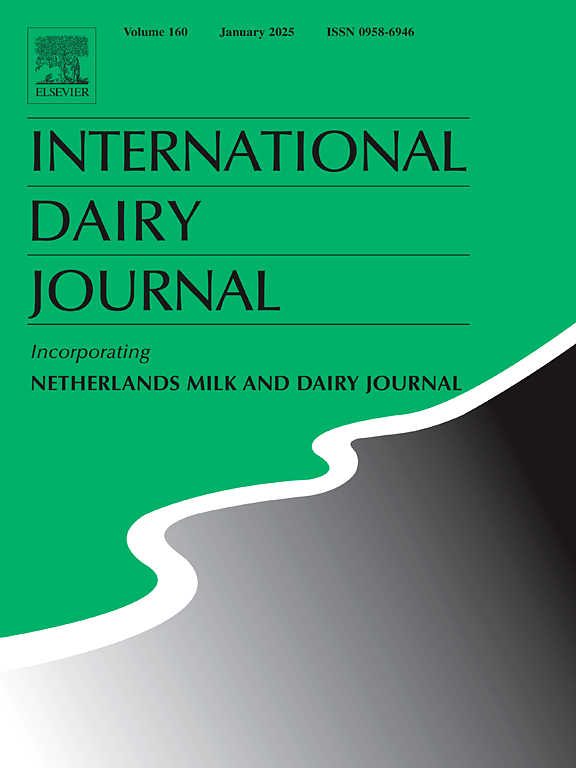工业规模超高压微流化器对牛奶微生物、活性蛋白、物理性质和脂质的影响
IF 3.1
3区 农林科学
Q2 FOOD SCIENCE & TECHNOLOGY
引用次数: 0
摘要
本研究探讨了工业级超高压微流控器(1 t/h)在4℃进料温度和50 ~ 250 MPa压力下,微生物、活性物质、物理性质和脂质的变化。在250 MPa压力下,细菌总数、大肠菌群和嗜冷菌数量分别减少4.43、2.47和3.08 log CFU/mL。细菌总数的减少显著高于巴氏奶(PM20, P <;0.05)。免疫球蛋白lgG(229.56±4.5 mg/L)、乳过氧化物酶(3349.74±106.39 U/L)、α-乳白蛋白(3349.74±106.39 mg/L)、β-乳球蛋白(3749.28±29.95 mg/L)含量显著高于PM (P <;0.05)。250 MPa微流态化乳的Turbiscan稳定性指数低于巴氏奶,而其粒径(D3,2和D4,3)与巴氏奶相似(P >;0.05)。对巴氏灭菌奶和250 MPa微流化奶进行脂质组学分析,鉴定出7种脂质作为潜在的差异标记物。这为用工业微流化牛奶取代传统的巴氏杀菌牛奶提供了技术基础。本文章由计算机程序翻译,如有差异,请以英文原文为准。
Effects of industrial-scale, ultrahigh-pressure microfluidizer on microorganisms, active proteins, physical properties, and lipids of cow’s milk
This study explored changes in microorganisms, active substances, physical properties and lipids in response to industrial-grade ultrahigh-pressure microfluidizer (1 t/h) at a 4 °C feed temperature and pressures ranging from 50 to 250 MPa. At 250 MPa pressure, total bacteria, coliforms, and psychrotrophics counts decreased by 4.43, 2.47, and 3.08 log CFU/mL, respectively. The reduction in total bacteria count was significantly higher than that of pasteurized milk (PM20, P < 0.05). Content for immunoglobulin lgG (229.56 ± 4.5 mg/L), lactoperoxidase (3349.74 ± 106.39 U/L), α-lactalbumin (3349.74 ± 106.39 mg/L), β-lactoglobulin (3749.28 ± 29.95 mg/L) were significantly higher than that of PM (P < 0.05). The Turbiscan Stability Index of 250 MPa microfluidized milk is lower than pasteurized milk, whereas its particle sizes (D3,2 and D4,3) were similar from those of pasteurized milk (P > 0.05). Lipidomics analysis of pasteurized, and 250 MPa microfluidized milks identified 7 lipids as potential differential markers. This provides a technical basis for replacing traditional, pasteurized milk with industrially microfluidized cow’s milk.
求助全文
通过发布文献求助,成功后即可免费获取论文全文。
去求助
来源期刊

International Dairy Journal
工程技术-食品科技
CiteScore
6.50
自引率
9.70%
发文量
200
审稿时长
49 days
期刊介绍:
The International Dairy Journal publishes significant advancements in dairy science and technology in the form of research articles and critical reviews that are of relevance to the broader international dairy community. Within this scope, research on the science and technology of milk and dairy products and the nutritional and health aspects of dairy foods are included; the journal pays particular attention to applied research and its interface with the dairy industry.
The journal''s coverage includes the following, where directly applicable to dairy science and technology:
• Chemistry and physico-chemical properties of milk constituents
• Microbiology, food safety, enzymology, biotechnology
• Processing and engineering
• Emulsion science, food structure, and texture
• Raw material quality and effect on relevant products
• Flavour and off-flavour development
• Technological functionality and applications of dairy ingredients
• Sensory and consumer sciences
• Nutrition and substantiation of human health implications of milk components or dairy products
International Dairy Journal does not publish papers related to milk production, animal health and other aspects of on-farm milk production unless there is a clear relationship to dairy technology, human health or final product quality.
 求助内容:
求助内容: 应助结果提醒方式:
应助结果提醒方式:


